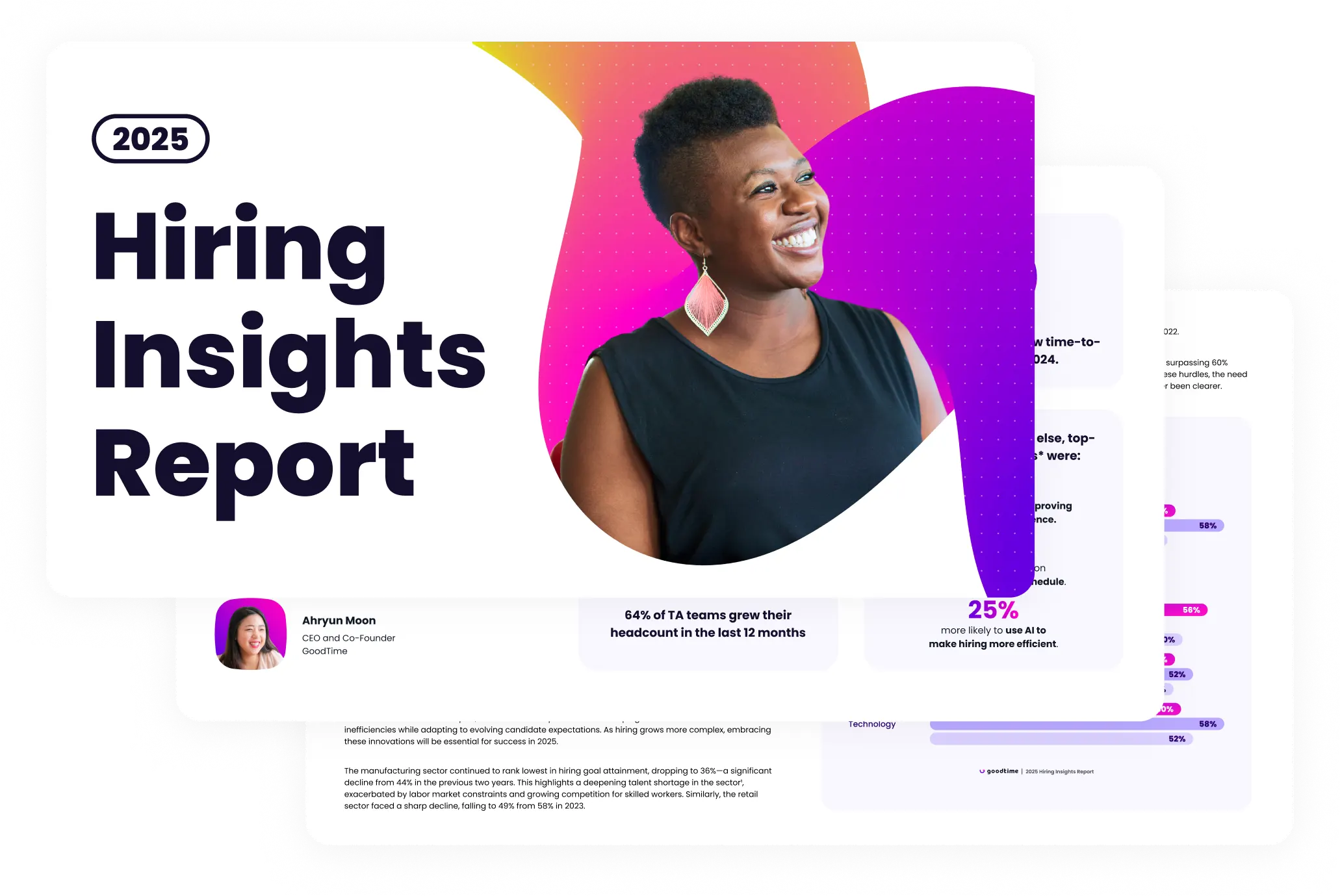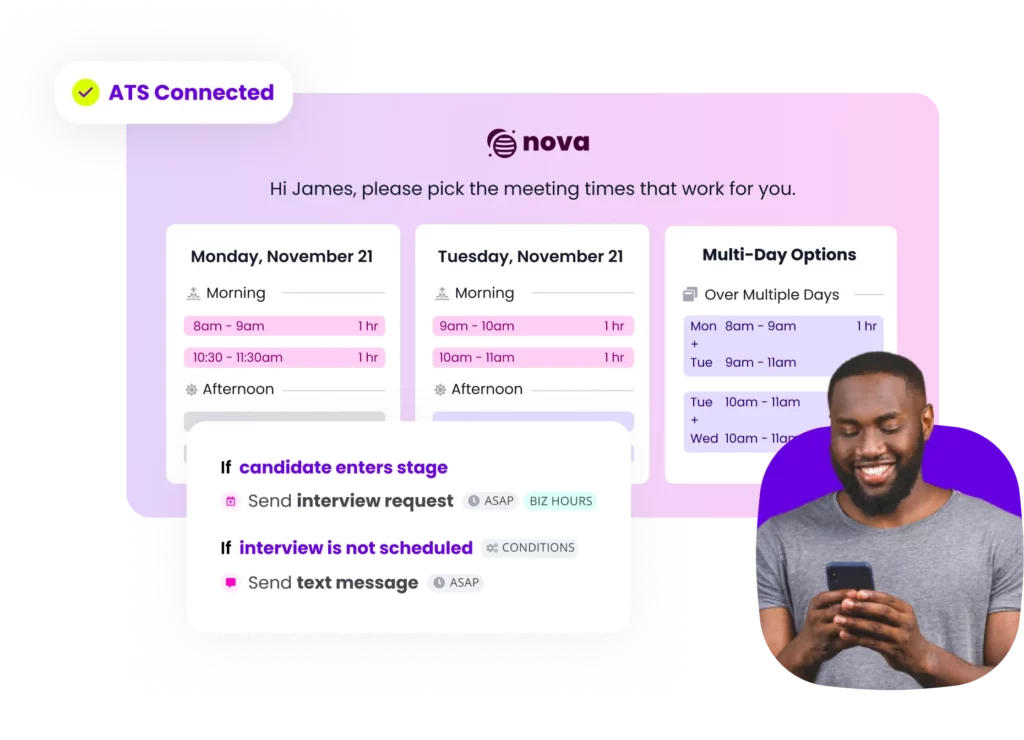Finding the perfect candidate for a position can sometimes feel a little maddening, especially as applications start flooding in. You want to give everyone a fair chance but must also control your time-to-hire.
What if there was a simple way to streamline your essential hiring process steps and get the most out of each one? You can’t skip steps like skills assessment and interviewing, but you can speed the process with candidate screening.
A candidate screening process lets you check applicant credentials against set criteria. Those who meet those criteria move forward in the system. Given a clear hiring rubric and an effective screening system, you can quickly identify the best-fit candidates and filter out those less qualified. The result is a better candidate experience with streamlined time-to-hire.

Unlock 2025’s top hiring strategies: Insights from 500+ TA leaders
Be the first to uncover deep hiring insights specific to your sector — straight from the highest-performing TA teams.

Best practices for screening candidates
Candidate screening quickly filters out unqualified applicants, freeing up more time to build relationships with stronger candidates. The key is to define your standards as clearly as possible.
According to Sara Ashraf, talent acquisition specialist and assistant manager of HR operations at Big Immersive, clear standards make the screening process optimally efficient and effective:
“Before delving into candidate evaluation, it’s crucial to outline the key skills, qualifications, and attributes that align with the position’s requirements. Establish measurable benchmarks for comparison and identify deal-breakers that warrant automatic disqualification. By articulating screening standards from the outset, organizations enhance efficiency and ensure a targeted and purposeful candidate selection process.”
With a defined set of criteria, you can implement any candidate screening options into your hiring workflow.
Resume screens
As a TA pro, you know how time-consuming it is to review every resume that comes in manually, and the time burden is only increasing. According to LinkedIn data, the number of applicants per job has risen significantly in the past few years. U.S. companies receive an average of 2.5 applicants per job in 2024, compared to 1.5 in 2022.
Resume screening lets you automatically filter incoming resumes for selected skills and abilities. Screening tools scan resumes for variations on keywords and phrases related to job requirements.
As the human in the room, you tell automated screeners what phrases signal a qualified candidate. It’s important to standardize your criteria and filter by skills and experience, avoiding any standards that could introduce bias. A fair and objective filter can effectively bring qualified candidates through the pipeline.
Phone screens
As you know, some job candidates have the right skills on their resumes but aren’t suitable for the position. Phone screens let you filter out those candidates and highlight people who are a better match, both skills-wise and in terms of personality.
These screens should go beyond what’s on a candidate’s resume while still being standardized. The Society for Human Resources Management (SHRM) recommends standardized phone screening questions with a ratings “scorecard,” meaning every phone interviewer evaluates candidates based on the same criteria.
However, because this is the first chance for a back-and-forth conversation, screening interviewers should be ready to ask follow-up questions if something important arises. An unexpected detail, prompted by initial questioning, can be the defining factor that moves someone forward.
Structured interviews
A structured interview is a standardized assessment of how candidates behave in certain situations. All candidates answer the same questions in the same order, and evaluators grade responses using a standard rubric.
The strength of a structured interview is that it takes an otherwise subjective competency, like interpersonal skills and collaboration, and makes it measurable. The main requirement is a detailed evaluation guide and well-trained evaluators.
Leveraging technology for efficient screening
Top teams are focusing most on improving efficiency in hiring, according to GoodTime’s 2024 Hiring Insights Report:
Technology can make the interview process significantly more efficient. In the screening process, artificial intelligence (AI) and automated systems process responses and sort candidates faster than human eyes.
“By incorporating [screening] tools, recruiters can efficiently narrow down the pool of applicants, saving time on reviewing resumes, expediting interview scheduling, and promptly identifying potential concerns or gaps in candidates’ profiles. This proactive approach enhances the overall efficiency of the screening process and ensures a more targeted and informed selection of candidates for further evaluation.”
-Sara Ashraf
Tools like applicant tracking systems (ATS) and recruiting automation solutions incorporate screening into workflows. Events within the hiring process trigger the sending of a screener, so HR teams don’t have to do so manually for every applicant. With those time savings, teams can focus on pre-qualified candidates.
According to our Hiring Insights Report, candidate review is the most popular application of AI in recruitment:
Those 45% of respondents benefit from having fewer administrative tasks on their plate. With that freed-up time, they can spend more time with top candidates and cultivate meaningful relationships.
Methods for pre-screening candidates
There’s a screening method for anything your organization needs to evaluate, from niche technical skills to interpersonal competencies. Here are several of the most common.
Knockout questions
Knockout questions immediately eliminate candidates who don’t meet essential requirements. You can use them at any point during the application process to narrow your candidate pool, sometimes significantly.
Knockout questions should have definitive acceptable and unacceptable answers. For example:
- Do you hold [certification]?
- How many years of experience do you have in [industry or type of role]?
- Are you comfortable with [essential task]?
- Are you physically able to [essential task]?
Knockout questions are easy to work into your application workflow. You can send one question or several as long as your software knows what to do with each response.
Skills assessments
As you may have noticed, there’s a strong push in the HR world to focus on candidates’ skills and practical experience instead of background or credentials. Ninety-four percent of surveyed employers believe skills-based hiring reflects success better than resume review, and 81% describe their hiring as skills-based. That percentage is up from 73% in 2023 and just 56% in 2022.
Skills assessments evaluate a candidate’s proficiency at key job functions. They often take the form of hands-on tests or knowledge-based quizzes. The results let you easily compare candidate competencies and offer insights into potential future performance.
Cultural fit questions
If culture fit is a priority in your hiring process, screening for it can help you streamline your candidate pool and save valuable interview time. It’s much more efficient to send these questions automatically to people who reach a certain point in the interview process than to ask the same question in every interview.
Automated screeners also reduce bias that can creep into cultural fit assessments. With a screening tool, you can standardize the questions you ask and the answers you prefer.
Behavioral interviews
Behavioral interviews use a candidate’s past experiences to assess their chances of success in a role. By asking about how a candidate handled a particular situation, you can predict the choices they’ll make in the future.
For this type of interview to work, you need focused questions and behavioral interview training for your team. Interviewers must understand how to interpret answers and craft meaningful follow-up questions to get the most valuable information from each response.
Challenges and common pitfalls in candidate screening
Candidate screening can make your hiring workflow more efficient, but it’s essential to distinguish efficiency from speed. Efficiency requires high-quality results, which respondents to our Hiring Insights Report identified as the most crucial success metric in HR:
Candidate screening can improve hire quality by eliminating unqualified candidates. It also gives you more time to focus on top candidates, allowing you to ensure the right person for the job. For that to happen, you need to avoid “convenience traps” — screening design mistakes that fail to filter out poor candidates. Those traps include:
- Over-reliance on keywords: If you use an ATS, it’s tempting to center your resume screening process on keywords that match the job description. Keyword scanning can be part of the process, but candidates may describe their qualifications differently. Search for all variations of each keyword you filter for, including alternate phrasing, and avoid letting a single keyword be the reason you eliminate a candidate.
- Failing to dig deeper: Screeners should move people forward based on their skills and experience, but you must verify that those skills will translate to job success. Keep asking questions until you fully understand a candidate’s skill level and what their experience has taught them. In short, be sure they have the abilities they claim.
Screeners are valuable tools, but their ultimate purpose is to free up time for the human element of hiring. Don’t get so caught up in the efficiency of automation that you forget to connect.
Candidate screening FAQs
Candidate screening is the process of evaluating applicants against predefined criteria to quickly identify the most qualified candidates for a job.
Screening saves time and improves hire quality by filtering out unqualified candidates early in the process, allowing recruiters to focus on the best-fit applicants.
Popular methods include resume screens, phone screens, skills assessments, and structured interviews. Each method helps assess different aspects of a candidate’s fit for the role.
Knockout questions are specific questions that eliminate candidates who don’t meet essential requirements. They are used to quickly narrow down the candidate pool.
Automation tools, like applicant tracking systems (ATS), streamline the screening process by scanning resumes, administering assessments, and managing applications efficiently.
Standardize your criteria and use objective filters, such as skills and experience, to avoid bias. Make sure screening tools are aligned with job requirements.
A skills assessment evaluates a candidate’s abilities through tests or quizzes related to the job, providing insight into their practical capabilities.
Avoid over-reliance on keywords and ensure you dig deeper into a candidate’s experience to verify their qualifications and skills.
Building an effective screening process
As job seekers flood employers with more applications, efficiency will become more critical. Fortunately, this problem has developed alongside a valuable solution: AI-driven automation.
Automated screening tools let you process more candidates in the same amount of time without sacrificing the quality of your hires. The right screeners at the right time can even improve hire quality by flagging promising candidates that human reviewers might miss.
GoodTime’s interview scheduling software seamlessly integrates screening into your hiring workflow with customizable knockout questions and other application review features. You pop them into your process where they make sense and get a more refined hiring funnel, with the potential for shorter time-to-hire and less processing time per application. Give it a try today and see how it can transform your process.
AI for more human hiring
Interview scheduling is just the start. Use human-centric AI to elevate your hiring experience while automating 90% of interview scheduling tasks — for any role, in any place, at any scale.





